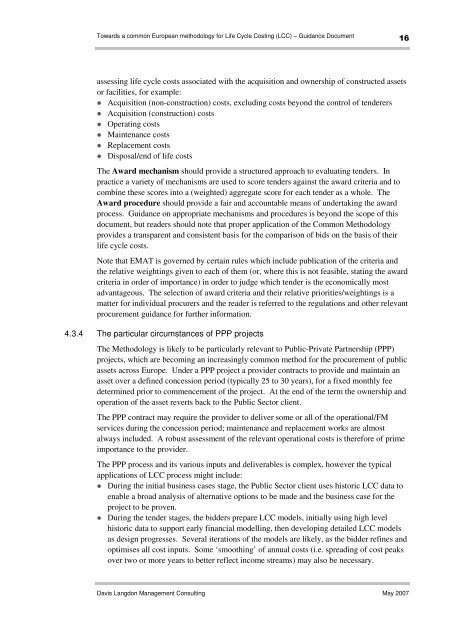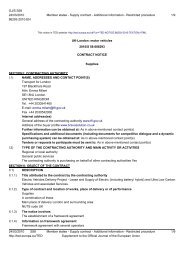Life cycle costing (LCC) as a contribution to sustainable construction ...
Life cycle costing (LCC) as a contribution to sustainable construction ...
Life cycle costing (LCC) as a contribution to sustainable construction ...
Create successful ePaper yourself
Turn your PDF publications into a flip-book with our unique Google optimized e-Paper software.
Towards a common European methodology for <strong>Life</strong> Cycle Costing (<strong>LCC</strong>) – Guidance Document<br />
16<br />
<strong>as</strong>sessing life <strong>cycle</strong> costs <strong>as</strong>sociated with the acquisition and ownership of constructed <strong>as</strong>sets<br />
or facilities, for example:<br />
Acquisition (non-<strong>construction</strong>) costs, excluding costs beyond the control of tenderers<br />
Acquisition (<strong>construction</strong>) costs<br />
Operating costs<br />
Maintenance costs<br />
Replacement costs<br />
Disposal/end of life costs<br />
The Award mechanism should provide a structured approach <strong>to</strong> evaluating tenders. In<br />
practice a variety of mechanisms are used <strong>to</strong> score tenders against the award criteria and <strong>to</strong><br />
combine these scores in<strong>to</strong> a (weighted) aggregate score for each tender <strong>as</strong> a whole. The<br />
Award procedure should provide a fair and accountable means of undertaking the award<br />
process. Guidance on appropriate mechanisms and procedures is beyond the scope of this<br />
document, but readers should note that proper application of the Common Methodology<br />
provides a transparent and consistent b<strong>as</strong>is for the comparison of bids on the b<strong>as</strong>is of their<br />
life <strong>cycle</strong> costs.<br />
Note that EMAT is governed by certain rules which include publication of the criteria and<br />
the relative weightings given <strong>to</strong> each of them (or, where this is not fe<strong>as</strong>ible, stating the award<br />
criteria in order of importance) in order <strong>to</strong> judge which tender is the economically most<br />
advantageous. The selection of award criteria and their relative priorities/weightings is a<br />
matter for individual procurers and the reader is referred <strong>to</strong> the regulations and other relevant<br />
procurement guidance for further information.<br />
4.3.4 The particular circumstances of PPP projects<br />
The Methodology is likely <strong>to</strong> be particularly relevant <strong>to</strong> Public-Private Partnership (PPP)<br />
projects, which are becoming an incre<strong>as</strong>ingly common method for the procurement of public<br />
<strong>as</strong>sets across Europe. Under a PPP project a provider contracts <strong>to</strong> provide and maintain an<br />
<strong>as</strong>set over a defined concession period (typically 25 <strong>to</strong> 30 years), for a fixed monthly fee<br />
determined prior <strong>to</strong> commencement of the project. At the end of the term the ownership and<br />
operation of the <strong>as</strong>set reverts back <strong>to</strong> the Public Sec<strong>to</strong>r client.<br />
The PPP contract may require the provider <strong>to</strong> deliver some or all of the operational/FM<br />
services during the concession period; maintenance and replacement works are almost<br />
always included. A robust <strong>as</strong>sessment of the relevant operational costs is therefore of prime<br />
importance <strong>to</strong> the provider.<br />
The PPP process and its various inputs and deliverables is complex, however the typical<br />
applications of <strong>LCC</strong> process might include:<br />
During the initial business c<strong>as</strong>es stage, the Public Sec<strong>to</strong>r client uses his<strong>to</strong>ric <strong>LCC</strong> data <strong>to</strong><br />
enable a broad analysis of alternative options <strong>to</strong> be made and the business c<strong>as</strong>e for the<br />
project <strong>to</strong> be proven.<br />
During the tender stages, the bidders prepare <strong>LCC</strong> models, initially using high level<br />
his<strong>to</strong>ric data <strong>to</strong> support early financial modelling, then developing detailed <strong>LCC</strong> models<br />
<strong>as</strong> design progresses. Several iterations of the models are likely, <strong>as</strong> the bidder refines and<br />
optimises all cost inputs. Some ‘smoothing’ of annual costs (i.e. spreading of cost peaks<br />
over two or more years <strong>to</strong> better reflect income streams) may also be necessary.<br />
Davis Langdon Management Consulting May 2007







